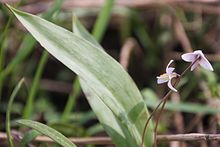Dwarf Trout Lily
| Erythronium propullans | |
|---|---|
 |
|
| Scientific classification | |
| Kingdom: | Plantae |
| (unranked): | Angiosperms |
| (unranked): | Monocots |
| Order: | Liliales |
| Family: | Liliaceae |
| Genus: | Erythronium |
| Species: | E. propullans |
| Binomial name | |
|
Erythronium propullans A.Gray |
|
Erythronium propullans (Minnesota dwarf trout lily, Minnesota adder's tongue, Minnesota fawnlily) is a rare plant endemic to the Cannon River and North Fork Zumbro River watersheds in Rice County, Goodhue County and the extreme northern edge of Steele County, Minnesota, in the United States. The plants are believed to be a mutation or sport of the white trout lily (Erythronium albidum) and evolved following the most recent ice age.
The plants flower in the spring at the same time as Hepaticas, Dutchman's breeches, Bloodroot, and other spring wildflowers. Nerstrand-Big Woods State Park, River Bend Nature Center, and several tracts owned by The Nature Conservancy protect portions of its habitat.
The lily was first noted by Mary Hodges, a high school science instructor at St. Mary's School (now Shattuck-St. Mary's) in Faribault, Minnesota, and then formally listed as a new species by botanist Asa Gray in 1871.
Research suggests that E. propullans rarely reproduces from seed on its own, but is highly dependent on vegetative reproduction, or limited cross pollination with Erythronium albidum, thus limiting population growth and spread of the species.
...
Wikipedia

